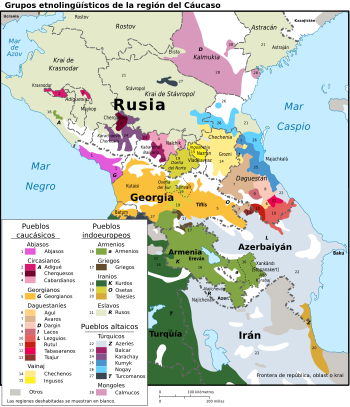Chechen language
Chechen is a Northeast Caucasian language and one of the two official languages of the Chechen Republic, Russia. The speakers of this language are able to understand each other, in a certain way, with the speakers of Ingush. Furthermore, Chechen has several dialects.
It is estimated that the number of speakers is around 1,330,000.
Chechen was written using the Arabic alphabet until the 1920s. Prior to the 20th century, Arabic was used for most communications in Chechnya, with Chechen primarily used as a colloquial language. Arabic lost popularity and Russian became the written language with the arrival of the Soviet Union. Most Chechen speakers are also fluent in Russian. The Latin alphabet began to be used to write Chechen in the mid-1920s instead of Arabic. In 1938 the Cyrillic alphabet was adopted. With the declaration of independence of the Chechen Republic of Ichkeria in 1992, the parliament of the self-proclaimed republic declared the use of the Latin alphabet official, but from the beginning the population did not understand it. The Latin alphabet for Chechen has fallen out of use since the end of the Second Chechen War and the reincorporation of Chechnya into Russia.
Geographic distribution
According to the 2010 Russian census, approximately 1,350,000 are able to speak Chechen. It is an official language in the republics of Chechnya and Dagestan.
Chechens in Jordan
Chechens in Jordan have always had good relations with the Hashemite monarchy and are allowed to live according to their language and traditional culture. The majority of Jordanian Chechens live and express themselves in their language. These Chechens are bilingual in Chechen and Arabic. They do not speak Arabic to each other, they only use Chechen to communicate with each other and have sometimes punished children for speaking Arabic at home. Some Chechens from Jordan often work as interpreters for people from Chechnya visiting the Arab country.
Dialects
The dialects of Chechen are Lowland Chechen (the basis of their literary language) and, according to the adjectival forms present in Russian sources, Cheberloiski, Sharoiski, Shatoisko-itumkalinski, Galanchzhoiski, Akkinski (the form used by the Chechens in the Khasaviurt area of Dagestan, also known as Aukhov Chechens) and the mountain dialect, split into two sub-dialects, Jildijaroiski and Maistinski, modalities of the Chechens who immigrated to eastern Georgia between the 17th and 17th centuries. late 19th century (although in Georgian sources these mountain Chechens, neighbors of the North Georgia Jevsur, Pshav and Tush tribes, appear as 'kist's').
Thus, Georgians mention a Kist' dialect, while the Georgian (Soviet) Encyclopedia maintains that Chechens residing in East Georgia use a mixed Kist'-Georgian dialect in family contexts.
Grammar
Uslar was the first to carry out a scholarly study of Chechen: his grammar, the second in order in his series of 7 monograms, appeared in 1888. Jakovlev, for his part, published in 1941 an extensive study on the syntax, but his separate morphological analysis, although completed in 1939, did not see the light of day until 1959.
Consonant play is simpler in Chechen than in neighboring Caucasian languages; there is no labialization, only a lateral one and the ejectives are reduced to 6. In total there are 34 consonants, some representing allophone positions and some exclusive sounds for loanwords. There are basically five vowels: i, e, a, o, u, although this series is greatly extended by palatalization, labialization, rounding, and nasalization.
The tonic accent goes on the first root of the syllable.
There is no genus, tending the nouns class, number and case. The markers to form the plural are -š and -y, as kor 'window', plural kor.a.š; belxalo 'worker', plural belxaloy; nana 'mother', plural nanoy.
The numbering from 1 to 10 is as follows: cha, ši', qo', di', pxi', yalx, worh, barh, iss, itt; 20 tqa, 30 tqeitt, 40 šöztqa, 100 b'e.
The conjugation of the verb is by grammatical class without reference to the person, distinguishing mode, aspect, tense and number.
Contenido relacionado
Official language
Manx language
Spanish subgroup
